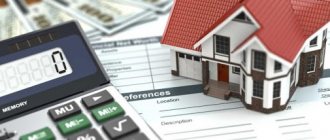Factors determining price
- First of all, this is the location of the property. The location near transport interchanges and important infrastructure facilities significantly affects the final cost of real estate.
- The next factor to consider is the presence of intermediaries. As a rule, property owners themselves do not search for buyers, but entrust this to intermediaries. This is immediately reflected in the value of the property, since it includes a percentage that will have to be paid to the intermediary for the work done.
- The final cost is also influenced by the location of the property in large business centers and non-residential administrative buildings converted into offices.
Operating costs
Operating expenses consist of utility bills, expenses for current and major repairs of the premises.
Their value directly affects the profitability and payback of the property.
Pay special attention to the operating costs of commercial premises in business centers. As a rule, utility bills and maintenance costs are noticeably higher than for street retail premises.
Also analyze whether the premises require additional investments in current and major repairs. It would be appropriate to negotiate their value based on their value.
How to independently calculate how much 1 sq.m. costs?
To do this, you can apply for the cadastral value of the property to the territorial body of the cadastral chamber. In addition, you can:
- visit a special website where the cost of 1 sq.m. will be indicated after the address of the premises is entered;
- request a cadastral extract;
- wait for the final decision of the municipal authorities who completed the assessment work.
If you want to calculate the cost yourself, then you should proceed as follows:
- find out the property or land tax rate established for a given region;
- multiply this bet by 200;
- multiply the resulting amount by the area of the object whose value is being assessed.
The use of online calculators and the average cost of premises
The average cost of real estate in Russia as a whole is as follows:
- The average cost of a meter of space located in an office near the Tverskaya metro station will be approximately 356 thousand rubles.
- In St. Petersburg, the average price per square meter is 109 thousand rubles. Retail space is valued higher - its average cost is 154 thousand per square meter.
- In Barnaul, buying commercial real estate is much easier and cheaper: on average, one square meter costs 34 thousand rubles. But this amount can increase to 57 thousand rubles.
There are also calculators on the Internet that help owners of commercial real estate easily calculate the approximate cost of housing. Among the most popular sites are the following:
- www.irn.ru - According to the information on the site itself, the calculator has been in operation for 9 years. During this time, approximately 4,000,000 commercial property valuations were completed. On the website you can specify the location of the property, type of building, floor, number of rooms. In addition, you can calculate the cost in rubles, dollars and euros.
- https://www.cian.ru -If you need to find out a more accurate cost of a property in Moscow and the region, CIAN provides a free calculator. In addition, on the site you can choose a property for yourself from thousands of verified advertisements. By comparing the assessment of the cost of an apartment and the assessment of the rental rate, it is also possible to determine the profitability of a particular object when renting it out.
- https://www.c-nn.ru - The calculator allows you not only to quickly estimate the value of commercial property, but also to determine its payback period and profitability.
Rent Forms
Based on global practice, it is advisable to offer the following forms of lease agreement:
1) Lease agreement of the “All inclusive” type. The owner pays all operating expenses, taking into account the possibility of their increase over time. Convenient for tenants who cannot adapt to changes in rent.
2) Net lease agreement. There can be three types:
- Basic rental. The tenant pays base rent and bears its share of operating expenses.
- Double net lease. The first type includes the costs of repairs and maintenance of the house.
- Triple net lease. The tenant is responsible for all operating expenses, including major repairs.
The owner’s benefit here is the opportunity to share the financial burden with the tenant.
3) Rent with expense limit. The owner pays a fixed amount, the tenant pays for everything that is not included in it. Thus, they share the load among themselves. The cost limit indicator is the first year's costs. This means that the tenant bears all costs on top of the fixed amount during the rental period after the second year. In this case, as with a net lease agreement, the costs associated with increased costs are borne by the lessee.
The lease agreement specifies the choice of one or another type of rent and details the responsibilities of the owner and the tenant. The agreement is signed by both parties.
Turning to global experience, we note that in the UK the tenant is responsible for repairs and maintenance of the basic elements of the house. Rental income is easy to predict, rent is revised only upward, and the parties practically do not break the contract.
In the United States and European Union countries, the owner is usually responsible for repairs and maintenance of the home's structural elements. Rental income is difficult to predict; it is possible to cancel the contract.
What does it mean?
Commercial real estate valuation allows you to determine the market value of real estate that can generate income. Traditionally, real estate appraisal is necessary when you need to sign a purchase and sale agreement . Thanks to expert opinion, the seller will be able to avoid inflated prices and, as a result, lack of demand for real estate.
For a future buyer, having an expert independent assessment will also be a significant advantage, which will help avoid many disputes due to a likely unreasonable price.
In addition, the valuation of income-generating real estate is necessary:
- When contacting the bank. A property is recognized as collateral only after it has been assessed by an expert. In addition, banks are willing to provide more favorable loan offers secured by real estate.
- With insurance. If the owner wishes to insure his property, a document must be provided to the insurance company on the basis of which the amount of insurance premiums and the amount of possible compensation in the event of an insured event will be determined.
- In legal proceedings. Property must be valued when dividing property.
- For investment. Thus, the investor will be able to see the full picture of the value of the property and will not be afraid of additional cash injections.
- When transferring property to third parties.
- When adding or removing commercial real estate from the balance sheet of an organization.
What do you need to consider?
As a rule, it is necessary to take into account the following indicators:
- duration of ownership of the area;
- calculation of costs for maintaining a property (payment of fees, maintaining infrastructure, etc.);
- the total cost of operating the building.
Important. The most important criterion for assessing commercial real estate is its profitability.
The step-by-step procedure for assessing real estate looks like this:
- Negotiations between the parties to the transaction. At this stage, problem areas and conditions for valuation services are discussed.
- Concluding a transaction agreement. It is permissible not to have it certified by a notary.
- Providing a package of documents by the customer.
It includes:- certificate of ownership of the premises (provided by the Unified State Register);
certificate of ownership of the land plot on which the object is located;
- documents from the technical inspection bureau.
- This is followed by an inspection visit to the site by an assessment specialist. He draws up an inspection report and photographs the object.
- The final stage is the preparation of an assessment report.
Methods used
Profitable
An appraiser determines how much income a particular office or retail space can generate.
Main stages:
- calculation of operating costs of the property being assessed;
- assessment of losses from uncollected rent payments (based on market indicators, as well as its dynamics);
- rough estimate of potential income.
Comparative
The basis of this approach is the principle of substitution. The main goal of the method is to find out the threshold, which is key for the buyer: if there are already a number of offers in a similar price category on the market, why should he pay attention to this particular object. When using the comparative method, the collection of information on completed transactions is examined, and a selection of comparable objects is carried out.
Among the advantages of the comparative approach it is customary to highlight:
- static validity;
- reflection of the opinions of buyers and sellers;
- the ability to take into account inflation and changes in financial conditions in the price tag;
- ease of use.
Among the disadvantages are:
- high difficulty in obtaining information about the actual sales price;
- direct dependence on market activity and its stability;
- the difficulty of obtaining information about the special terms of the transaction.
Expensive
It implies that the buyer will not spend money on a property whose total cost will exceed the cost of building the property from scratch. This option is suitable when justifying new construction, as well as when choosing the most optimal option for using land.
The main stages of the cost method: calculating the cost of constructing a similar building, assessing the moral and physical deterioration of buildings, adding the cost of land to the actually calculated cost of the building.
Among the advantages of the cost method it is customary to highlight:
- the greatest reliability when assessing only constructed objects;
- feasibility and greatest accuracy when assessing special and government facilities, as well as when analyzing the effectiveness of a land plot.
Disadvantages of the cost method:
- the difficulty of calculating the price tag for the reproduction of old buildings;
- the market value of real estate and costs are not always equivalent;
- the problematic nature of assessing sites located in some regions of Russia.
When conducting an assessment, a specialist must use all three methods of real estate assessment, the combined indicators of which will give a real picture of the price of the premises.
What is real estate valuation
Real estate appraisal is a procedure by which a person with special knowledge determines the market value of a particular property.
The following features are typical for real estate valuation:
- Targeting (the procedure is always carried out in relation to a specific object);
- The procedure is always caused by the need to carry out a specific type of transaction with a property;
- The participants are the appraiser and the customer;
- The assessment conclusion has its legal force only for a period of time established at the legislative level.
A person can turn to the services of an appraiser voluntarily or compulsorily in cases established by law.
Currently, real estate valuation is carried out in the following cases:
- Registration of a real estate purchase and sale transaction;
- Entry into inheritance rights;
- Obtaining mortgage funds;
- Consideration of disputes related to property;
- Privatization or insurance of real estate.
The main participants in legal relations are the appraiser - an individual who evaluates objects on a professional basis, as well as the owner of the property or other interested party.
You can see how real estate valuation methods are used in practice in this video:
Classification of real estate valuation methods
In order to determine the market value of any real estate, appraisers use several methods:
- Expensive;
- Comparative;
- Profitable.
Cost method
The cost method of determining value is a set of valuation methods that represents the determination of the amount of all expenses that an interested party may incur in the event of a complete restoration of an object or the creation of a similar new object.
The basis for this method is the provision according to which the interested party will not pay a larger amount for a finished object than for the creation of a new object of the same value.
To determine the price, the following data on costs associated with:
- Construction process;
- Purchase of materials for construction;
- Market value for construction equipment.
Algorithm of actions for the cost method:
- Determining the value of a real estate object, taking into account its most effective use;
- Determination of costs for new construction of a similar facility;
- Determination of wear;
- Determination of cost taking into account possible improvements;
- Determination of the final cost of the object.
Stages of assessment using a comparative approach.
Comparative cost method
The comparative method is a procedure for assessing a real estate property based on available data on similar transactions, as well as the cost of similar objects.
In order for the responsible person to apply this method, the following conditions must be met:
- The object does not have to meet the uniqueness condition;
- Information on transactions carried out must be complete and comprehensive;
- Factors that influence the value of an object specified in transactions must be comparable with the data presented about the object.
Stages of the comparative method:
- Identification of similar objects on the real estate market;
- Checking available information on transactions in relation to these objects;
- Introduction of adjustments for non-matching characteristics;
- Establishing the value of the object.
Main stages of the income method
The income method is a process for determining value based on the principle of obtaining income from the purchased property. This means that its value must be commensurate with its quality and the amount of income that can be obtained from its resale in the future.
Characteristic stages:
- Obtaining data on the income that an interested person can acquire when using the property (the average price for renting similar objects is taken as a basis);
- Obtaining data when using the property incompletely;
- Calculate the difference between the first and second data.
Features of the cost approach to assessment.
Stages
Where to contact?
First of all, you need to contact a special company that provides this type of service. After this, you need to decide on the purpose of the assessment.
What documents are required?
- Certificate of registration of ownership.
- Floor plan.
- Certificate of book value of the premises (issued by the accounting department).
- BTI passport for the building in which the property is located.
Important. An independent assessment of the cost of all objects allows us to consider it from the cost of building materials to the final execution of documents.
Procedure
The specialist points out:
- Address of the object;
- type of commercial property;
- total area;
- the purpose of the assessment.
The appraiser then writes a report.
Often, an independent expert assessment is required when resolving legal disputes. In this case, the qualifications of the specialist are important (licenses and certificates, as well as other documents confirming the expertise of the appraiser).
How to do it?
First of all, you need to contact a company that provides similar types of services. The main advantage of an independent assessment of commercial real estate is the ability to assess the profitability of the property as accurately as possible. For example, a factory building can be used for its intended purpose or rented out. The appraiser's task is to determine which type of use of the property will bring more income.
Deadlines
On average, real estate appraisal and preparation of the final report takes from two to five days.
Price
The cost of the appraiser’s services is influenced by the number of floors of the building, timing, purposes of the appraisal , etc. On average, the price tag for area estimates up to 500 sq.m starts from 5,000 rubles.
Commercial real estate valuation: pitfalls
ArticlesLeave a comment | Read comments
Sergey Sheshkov, managing partner of the Central Economics Group "Invest Project"
The concept of commercial real estate includes non-residential real estate objects that are used to make a profit. All commercial real estate is divided into several main types. These are office real estate (where the company's representative offices are located), retail (where various goods or services are sold to customers) and industrial and warehouse real estate (where various types of goods are produced and, accordingly, stored). Valuation of any property helps, first of all, to reduce unnecessary costs and time for market analysis. Therefore, the interaction between the business owner and the appraiser should be held under the motto: “they evaluate, we grow.” Commercial real estate valuation is a procedure associated with determining the market value of commercial real estate. Most often, an appraisal of commercial real estate is necessary to obtain a secured loan from a bank, a contribution to the authorized capital of an enterprise, preparation for a purchase and sale transaction, and when leasing the property. As practice shows, customers who need to evaluate commercial real estate want to determine the market value of the building itself or the market value of the rental rate for its use.
About the process of assessing commercial real estate. An independent assessment of commercial real estate, as a rule, includes several stages. The timing and quality of appraisal work depend not so much on the scale of the object, but on the level of professionalism of a particular appraisal company. In order not to make a mistake in choosing a contractor and to understand the assessment procedure, it is worth familiarizing yourself with all the stages of this process and the nuances that arise. So, the first stage is negotiations between the parties to the transaction and the conclusion of an assessment agreement. The conclusion of a contract is usually preceded by negotiations to determine the terms of the order and the possibility of its acceptance (refusal by the appraiser is not excluded). Negotiations are important for both the contractor and the customer, because at this stage the problem areas and tasks of the project, which are of mutual interest, are jointly discussed and a joint decision is made. When concluding a contract, certain conditions and fundamental principles must be observed. Regarding the assessment agreement, in Art. 10 of the Federal Law of July 29, 1998 No. 135-FZ “On Valuation Activities in the Russian Federation” establishes that the agreement must be concluded in writing and does not require notarization. Providing the customer with the documents necessary for the assessment is the second stage of the process of providing assessment services. These documents are usually sent to the appraiser's office after the contract is concluded. The list of documents that should be provided for such a procedure as the assessment of commercial real estate (buildings) is as follows:
1. Title documents for the building (premises) - certificate of state registration of the right.
2. Title documents for a land plot - a certificate of state registration of rights or a lease agreement, if the land plot is owned on a lease basis.
3. BTI documents:
- technical passport or extract from the technical passport (BTI form No. 1a);
- explication (BTI form No. 22);
- floor plan;
4. Accounting information:
- certificate of the book value of the valuation object;
- certificate of the residual value of the valuation object;
- information on operating costs - costs of insuring the property being assessed;
- utility bills (electricity, cold and hot water supply, heating, sewerage, etc.);
- wage fund for service personnel (security, cleaners, etc.);
- expenses for managing the subject of assessment (if any).
Many people, after reading the list of documents, panic, but there is no need to worry. In practice, the above list can be shortened. The exact list of documents will be determined after the appraiser has thoroughly familiarized himself with the assessment task and negotiated with the customer.
The third stage is an appraiser’s visit to inspect the property. At the appointed time, the appraiser meets with the customer, inspects and photographs the object, and draws up an inspection report. There are situations when an inspection turns out to be impossible, for example, in the case of a legal proceeding, when the owner denies the appraiser access to the inspected territory. And finally, the final stage is the preparation of an assessment report. Before the finished report falls into the hands of the customer, it is checked by the head of the assessment department or an employee authorized to check the report; in some companies, reports are not checked at all. And if the first version of the report is not compiled at an appropriate level, then it is returned for revision. The report must not be ambiguous or misleading. The report must indicate the date of the assessment of the object, the assessment standards used, the goals and objectives of the assessment and other information. All of the above stages relate to the assessment of any object; changes will only be made to the list of documents provided by the customer.
About factors influencing the valuation of commercial real estate. Valuation of commercial real estate is a complex, time-consuming process that depends on many factors, one of which is the location of the property. The dynamics of business development, and therefore the cost of the property, directly depends on the convenience of the location of commercial real estate. Every manager strives to choose the most successful location for his organization. If we talk about office space, it is no secret that the closer to the city center, the more developed the infrastructure, the higher the cost of the property. However, recent real estate market trends prove the opposite. The indicator “closer to the center is more expensive” is losing its importance due to new international class office complexes built outside the city center. Now only accessibility from the transport infrastructure becomes important. Evidence of the high investment attractiveness of such commercial real estate, such as warehouse real estate in the Moscow region, was the expert rating of the most expensive rental areas in the region. The main cost factors were transport accessibility and proximity to the Moscow Ring Road. The Novorizhskoe direction is the leader in terms of cost, with rental rates reaching $150 per sq. m. m. in year. The high cost of rent in this direction is largely due to the proximity to the Leningradskoe Highway, leading to Sheremetyevo Airport. On the direction Kyiv highway - Minskoe highway, the rental rate is $140 per sq. m. m. per year, which is due to the reconstruction of the Kyiv highway and the growing importance of Vnukovo airport. On Leningradskoye Shosse - Dmitrovskoye Shosse, rental rates reach $135 per sq. m. m. per year, primarily due to accessibility to Sheremetyevo airport. When assessing such objects, the parameter of accessibility of transport lines is taken into account first of all, but there are other factors that influence the assessment of commercial real estate. The value of the assessed commercial real estate object is influenced by the functional purpose of the object. Traditionally, the most popular, and therefore most expensive, real estate is retail. The most successful shopping malls are almost 100% full.
In 2011, the cost of renting retail space, for example, on Tverskaya Street more than doubled, to $8.5 thousand per sq.m., which allowed the Russian capital to return to the top ten cities with the most expensive space in the world. It is worth noting that it is much more difficult to evaluate commercial real estate if it does not directly generate income, but is used for the production of services or goods. In this situation, when assessing commercial real estate, appraisers find it difficult to determine which production assets brought profit to the enterprise. One of the important parameters when assessing a commercial real estate property is its total area. As you know, the larger the area of the object, the lower the cost per square meter. The quality of the interior finishing of the property being assessed is also a significant factor in determining its value. The better the quality of the finishing of the object, the higher the cost of one square meter. Moreover, the more favorable the location of the object, the more justified is the high quality of its finishing. The final cost of a commercial real estate property is influenced by a combination of many factors, and not by one individual parameter. How competently and adequately the property will be assessed depends solely on the competence, experience and professionalism of the appraiser.
Thus, the assessment of the market value of commercial real estate should be entrusted to professionals who have proven themselves to be highly qualified performers. To do this, you should, at a minimum, familiarize yourself with the list of letters of recommendation from the appraiser’s company (request directly or view on the corporate website). The scale of the organizations to which the appraiser provided services, as well as their positive reviews, is an important indicator of the level of services provided. Therefore, take seriously the choice of a company that will help make your business successful.
Share link on social networks:
Comments on the material: (no comments yet)
31473








